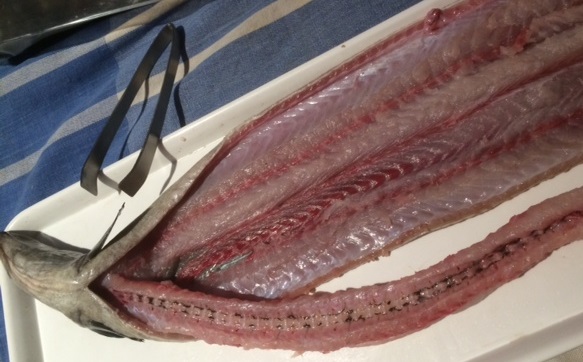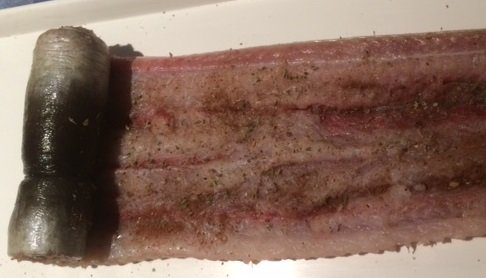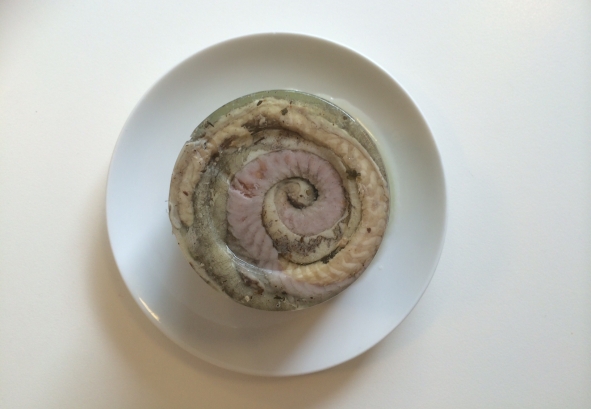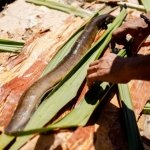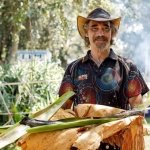Included in the line-up of ceremonies at Sydney Living Museums Eel festival this week included yours truly preparing a popular 19th-century delicacy, ‘collared eel’ following a recipe from 1816.
Collared Eel.
Bone a large eel, but don’t skin it: mix pepper, salt, mace, allspice, and a clove or two, in the finest powder, and rub over the whole inside; roll it tight, and bind with a course tape. Boil in salt and water till enough, then add vinegar, and when cold keep the collar in pickle. Serve it either whole or in slices.
Chopped sage, parsley, and a little thyme, knotted marjoram, and savoury, mixed with the spices, greatly improve the taste.
Maria Rundell, A new system of domestic cookery, 1816; Persephone Books, London, facsimile edition, p17.
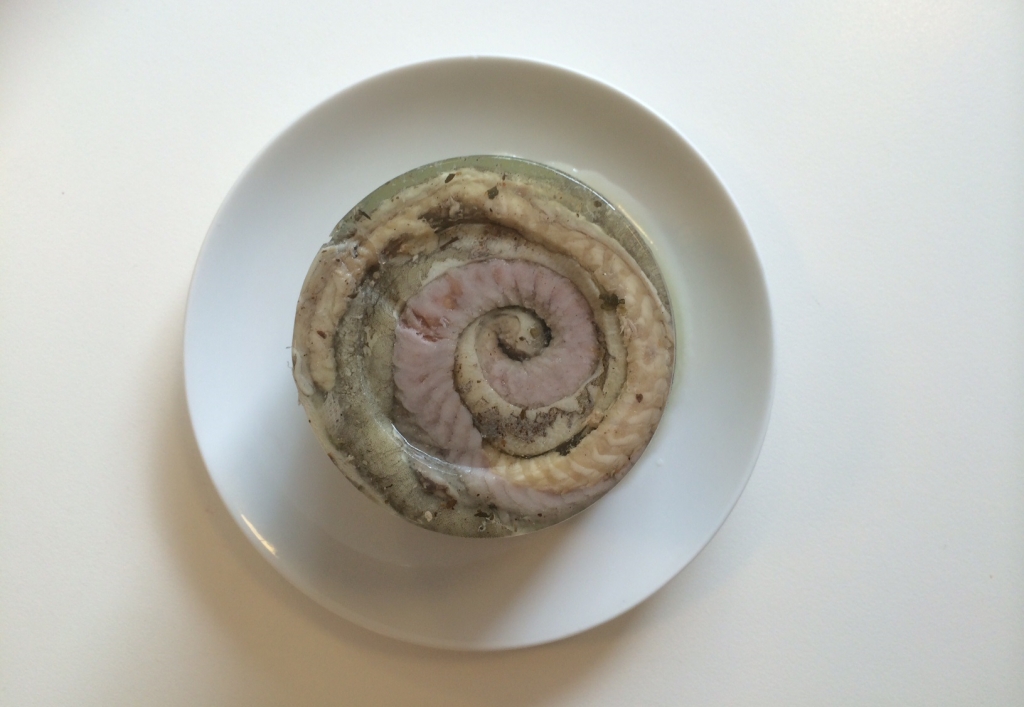
Collared eel, cooked, moulded and cooled. Photo © Jacqui Newling for Sydney Living Museums
On all the best tables
Collared eel was a popular enough dish to warrant its own dedicated serving ware, such as the colourful eel dish pictured above, from the Rouse Hill House and Farm collection. The Rouse’s serving dish, about 12cm in diameter, helps contain the rolled eel neatly, and the eel and surrounding jelly or aspic would be served straight from the pot. The lid has been broken and its staples indicate that it was valued enough to for someone to take the trouble to repair.

Decorative ceramic eel dish belonging to the Rouse family. Made by George Jones (1861-1872), Stoke On Trent. Rouse Hill House and Farm collection. Photo © Stuart Miller for Sydney Living Museums
Why collar?
We’ve discussed the art of collaring in a previous post ‘Slippery stuff’, but it is an all-but-lost art that survives in the form of Scandinavian pickled roll-mops, French roullades and Italian involtini. It is well suited to thin fillets of fish or meat that can be seasoned and rolled to make a more substantial and interesting dish for the table and eel is particularly well suited to this mode of preparation as it is a very gelatinous meat, and sets in its own jelly once it has been poached.
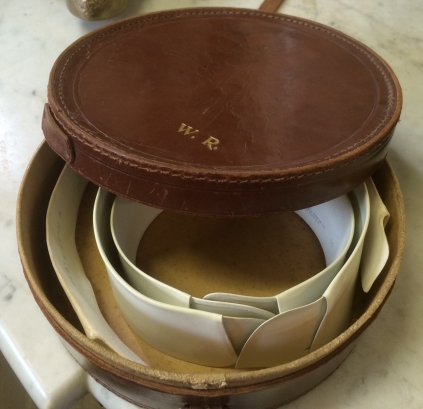
A gentleman’s collar box. Photo © Jacqui Newling
An arcane reference
The ‘collar’ reference for this type of thin rolled foodstuff comes from the practice of storing shirt collars, which were once a separate entity from the shirt itself. As the picture above shows, it was typical for gentlemen to store their collars in their own, and in this case personally initialed, collar box.
As collared eel is not a dish we commonly make these days, I road-tested the recipe in readiness for the festival – see some step-by-step pics below, but perhaps not for the squeamish. It was a fascinating process, the most difficult part being deboning the eel. Eels for culinary purposes and can be ordered from a good fishmonger, who may also, if you ask nicely, fillet them for you. The ones I buy from the Sydney Fish Market are wild caught from lakes above the Great Ocean Road in Victoria. You can also buy ready-to-eat smoked eels, which are much easier to bone and quite delicious served on a slice of cucumber with a dab of mayonnaise and fresh dill fronds.
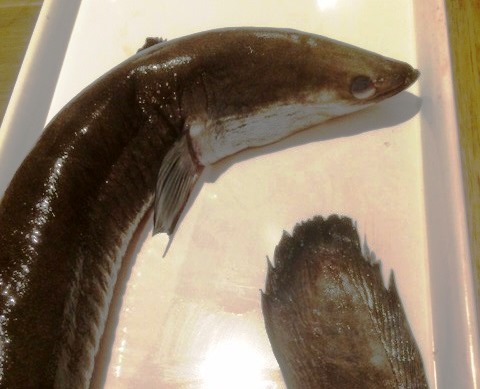
Fresh whole farmed eel, showing head and tail. Photo © Jacqui Newling for Sydney Living Museums
Collared eel
Directions
Eels in Sydney waterways
Eel was popular in England and colonists were delighted to find rivers teeming with them. They still frequent ponds and wetlands around Sydney – including the Royal Botanic Gardens, Centennial Park and in the stream and pond at our own Vaucluse House, yet the have a much broader global reach. Sydney’s eels migrate well into the Pacific Ocean, finding their way to Indonesian waters and as far as new Caledonia. You can read more about them here.
Eels are highly significant for Sydney’s Parramatta region. The name Parramatta is derived from Burramattaga in the local Darug language, meaning, ‘where eels lie’. The Barramattagal people would gather and feast, share stories and trade with neighbouring clans at the time of the eel season. Sydney Living Museums’ inaugural Eel Festival at Elizabeth Farm celebrated this Indigenous heritage with a family-friendly festival this month.

- Sydney Living Museums Eel Festival 2016 © Sydney Living Museums
The celebrations began in the evening on Friday April 22, with a traditional smoking ceremony and storytelling. This special ticketed event featured Indigenous elder Uncle Wes Marne, telling stories of his extraordinary life as we gathered around the fire bucket. The following day, Elizabeth Farm was host to a diverse range of family-friendly activities celebrating the Indigenous heritage of this special place, featuring talks, demonstrations and tastings about connections between Indigenous and non-Indigenous Australians and the ways eel was enjoyed in the time of the Macarthur’s residence at the Farm.
Wandering souls
Here is Mrs Beeton’s words of wisdom about eels in the UK
THE COMMON EEL.—This fish is known frequently to quit its native element, and to set off on a wandering expedition in the night, or just about the close of clay, over the meadows, in search of snails and other prey. It also, sometimes, betakes itself to isolated ponds, apparently for no other pleasure than that which may be supposed to be found in a change of habitation. This, of course, accounts for eels being found in waters which were never suspected to contain them. This rambling disposition in the eel has been long known to naturalists, and, from the following lines, it seems to have been known to the ancients:—
“Thus the mail’d tortoise, and the wand’ring; eel,
Oft to the neighbouring beach will silent steal.”
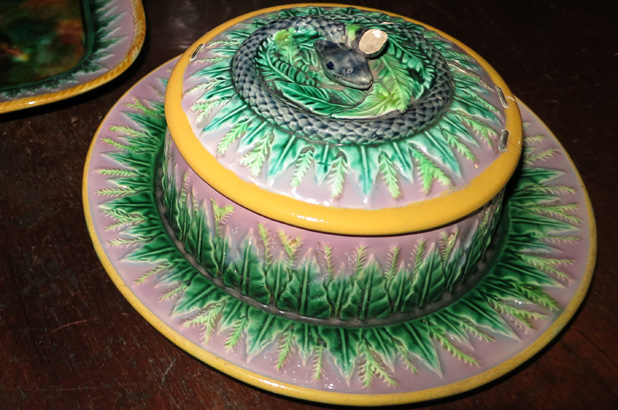
 Print recipe
Print recipe